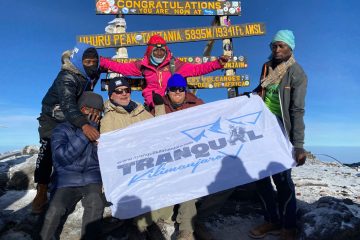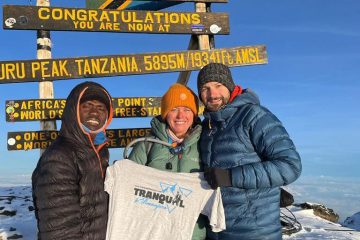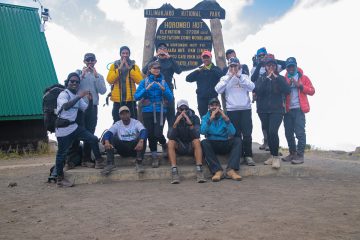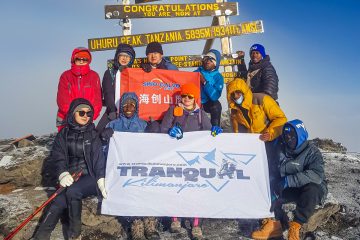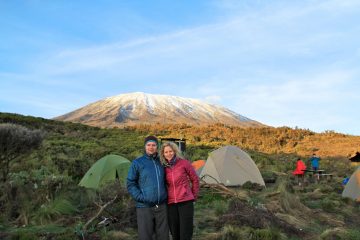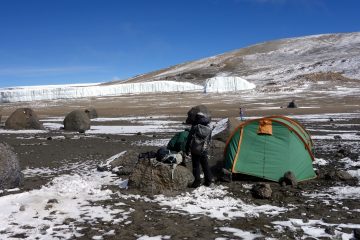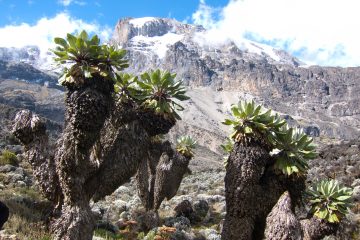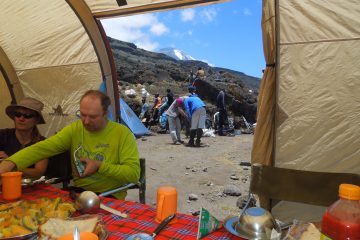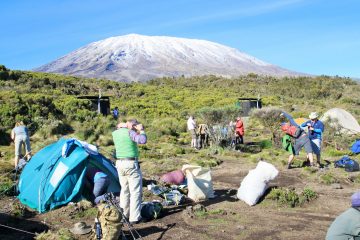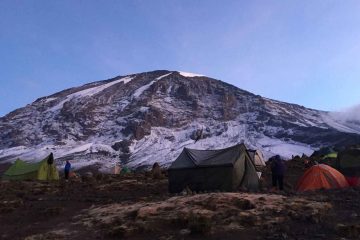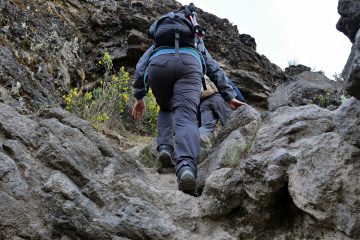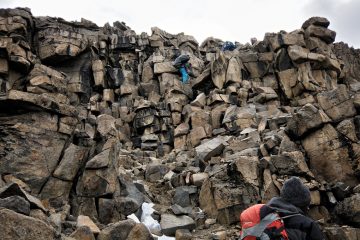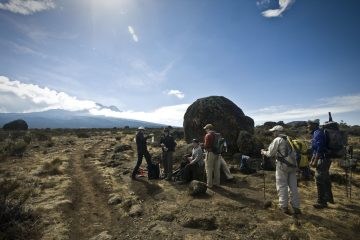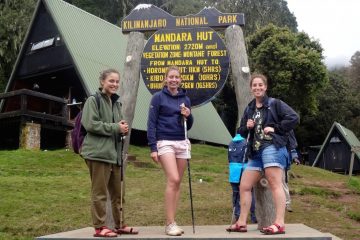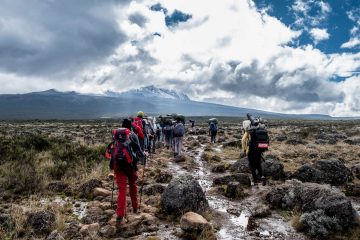All routes share similarities in sleeping conditions on Mount Kilimanjaro except for the Marangu Route. This particular route relies on huts as the primary form of accommodation, from start to finish. The rest of the routes namely, Machame Route, Lemosho Route, Umbwe, Shira, Western Breach, Rongai Northern Circuit all use tents and the sleeping conditions are in the form of camping.
Tents & Mattresses on Kilimanjaro
Camping tents on Mount Kilimanjaro should be durable, waterproof and sturdy to withstand the harsh cold conditions of the mountain therefore we use Mountain Hardwear’s rugged, 4-season tents.
Originally meant to accommodate three people at full house, we recommend two people to give enough room for gear and luggage bag for climbers.
An entrance cover at the front of the tent gives shelter for climbers to place muddy boots and gaiters.
These tents are manufactured to endure and tolerate strong winds, downpours, or heavy rain and snow cover, making them the best option for weather conditions while mountaineering.
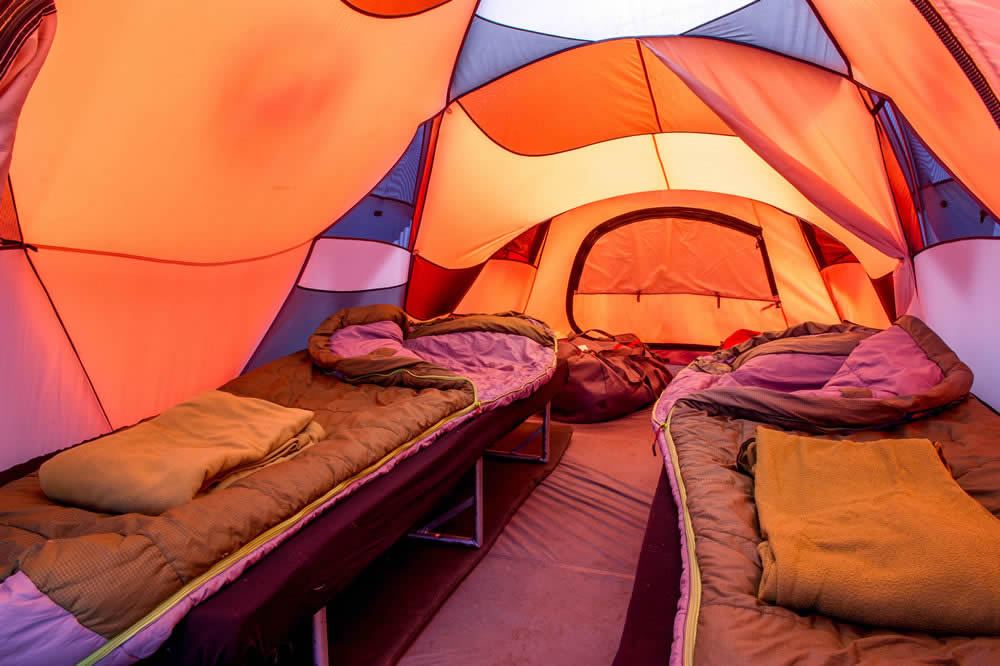
Who sets up camping Tents on Mount Kilimanjaro?
It is the work of the porters to set up tents for camping before you arrive at the campsite. By the time you arrive at the camp on Mount Kilimanjaro, your gear will be ready in the tent and your accommodation will be set, waiting for you to relax and rest overnight as you await the next day of trekking.
The campsites are level so the ground does not hold water even when it is raining, not subject to any water accumulation, the ground beneath is flat too meaning there are no rock outcrops to make your sleep uncomfortable.
As for mattresses, you are more than welcome to bring an extra one along with you but we will provide you with a decent mattress made of foam and will be insulated with waterproof material.
Sleeping Bags On Kilimanjaro
Sleeping bags are available for renting/hiring if at all you cannot purchase one or come with your own. This should be communicated earlier before you begin your climb so that we can arrange one for you. If you decide to bring your own sleeping bag, please ensure that it is rated -18 degrees Celsius (0 Fahrenheit) For more information about sleeping bags and which is the right one to choose for Mount Kilimanjaro, please follow this link.
To Rent or Buy a Sleeping bag?
Whether you chose to rent or buy a sleeping bag for your Mount Kilimanjaro adventure one thing will always stand, the sleeping bag has to be of great quality.
We can arrange for you to rent a sleeping bag suitable for the mountain conditions. All our rental equipment is well maintained and cleaned after every trip.
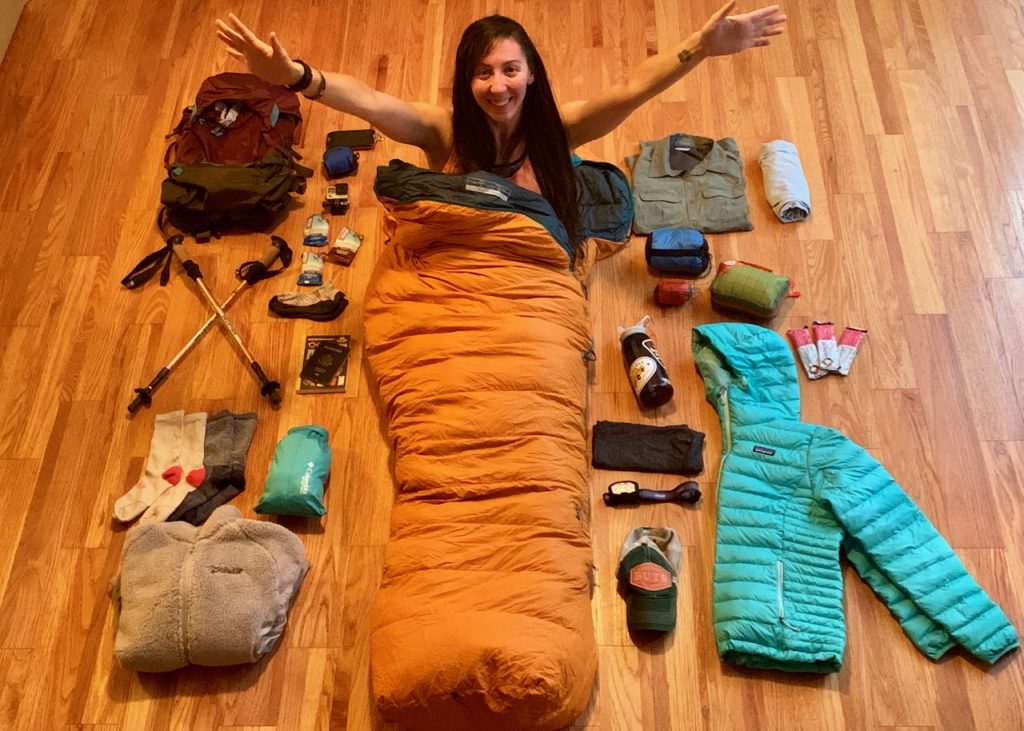
Fatigue, Cold & Altitude Considerations on Kilimanjaro
Keeping yourself warm at all times is very important, leaving parts of your body exposed to cold can be dangerous as fatigue wears down an even cold body and makes you feel colder even more. As you climb up more and gain more altitude, the air becomes thinner causing periodic respiration or breathing also known as Cheyne-Stokes Breathing due to respiratory issues which can make you feel uncomfortable.
You will need to be in great shape to combat fatigue and recover quicker from aches and pains as a result of trekking on the mountain.
Top Tips for a Warm & Comfortable Night in Your Tent
Below are some tips that will help you have a comfortable night and nice sleep on Mount Kilimanjaro:
Sleep System
Make it customary to always remove your sleeping bag from its compression sack and spreading it on your sleeping mat. This fluffs is up and allows insulation via the air between the synthetic fibres/feathers that traps warmth.
Always make sure that you do not place your sleeping bag close to the sides of the tent as it may become wet or damp causing your sleeping bag to condense due to cold, therefore comprising on insulation.
Use a fleece liner together with your sleeping bag for extra warmth.
Sleeping Clothes
Ensure that you have clothes set aside for sleeping. These clothes should be comfortable and keep you warm when you sleep. A warm base layer (top and bottom) and a pair of socks for warmth and comfort. At higher altitudes, it is recommended to wear more than one layer of clothing as it will get even colder and since most of your body heat will escape through your head, it is better to sleep in a warm hat.
Other ways to stay warm and comfortable on Kilimanjaro
- To keep your sleeping bag always insulated, keep it dry and warm, do not sleep in damp/wet clothes whatsoever.
- You can use hot water in an airtight container as a body or footwarmer in your sleeping bag.
- Despite of the loss of appetite, you will need a good supply of energy-providing foods as calories generate heat while at the same time giving you the required energy to carry on with your trek.
- When you leave for your daily trek, ensure you leave your clothes in your sleeping bag to keep them warm for your next night.
- If love a silent night, bring your earplugs along as sometimes the wind can be noisier the higher you climb.
- To make sure that you do not lose any heat while you sleep, empty your bladder(visit the toilet) before you sleep to avoid waking up in the cold at night.
- Sleeping pills are not recommended at all is the will affect your acclimatization routine and accelerate altitude sickness.
Tents are commonly used in almost all routes apart from the Marangu Route, if you are not used to camping, you can opt for the Marangu Route that uses huts and dorm-style cabins as a way of accommodation.
Follow this link to learn more about Mount Kilimanjaro’s packing list and equipment.


